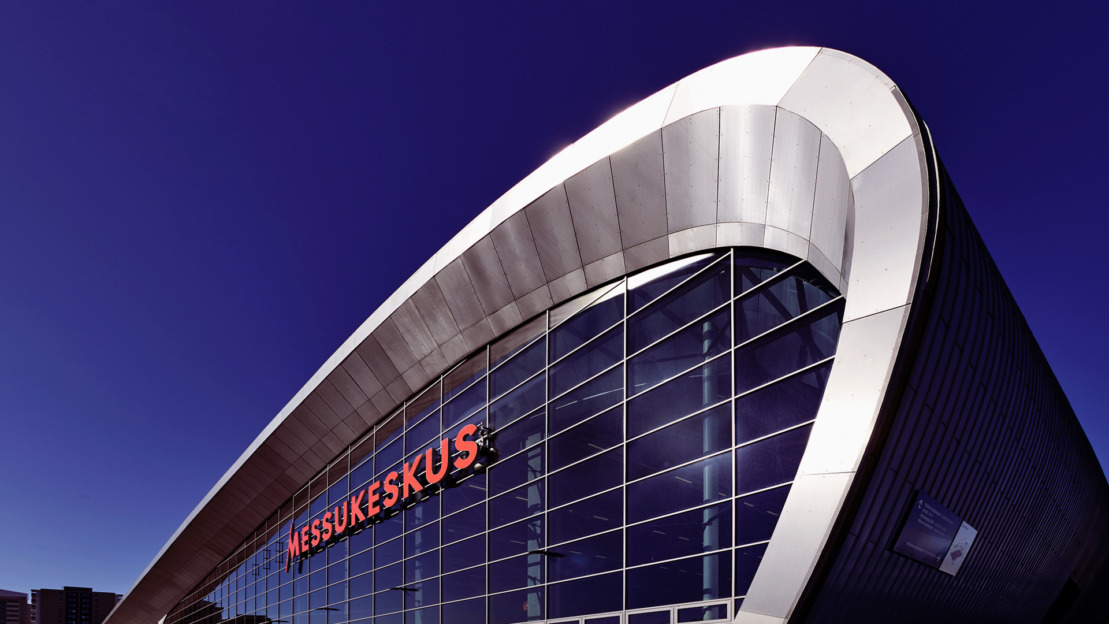
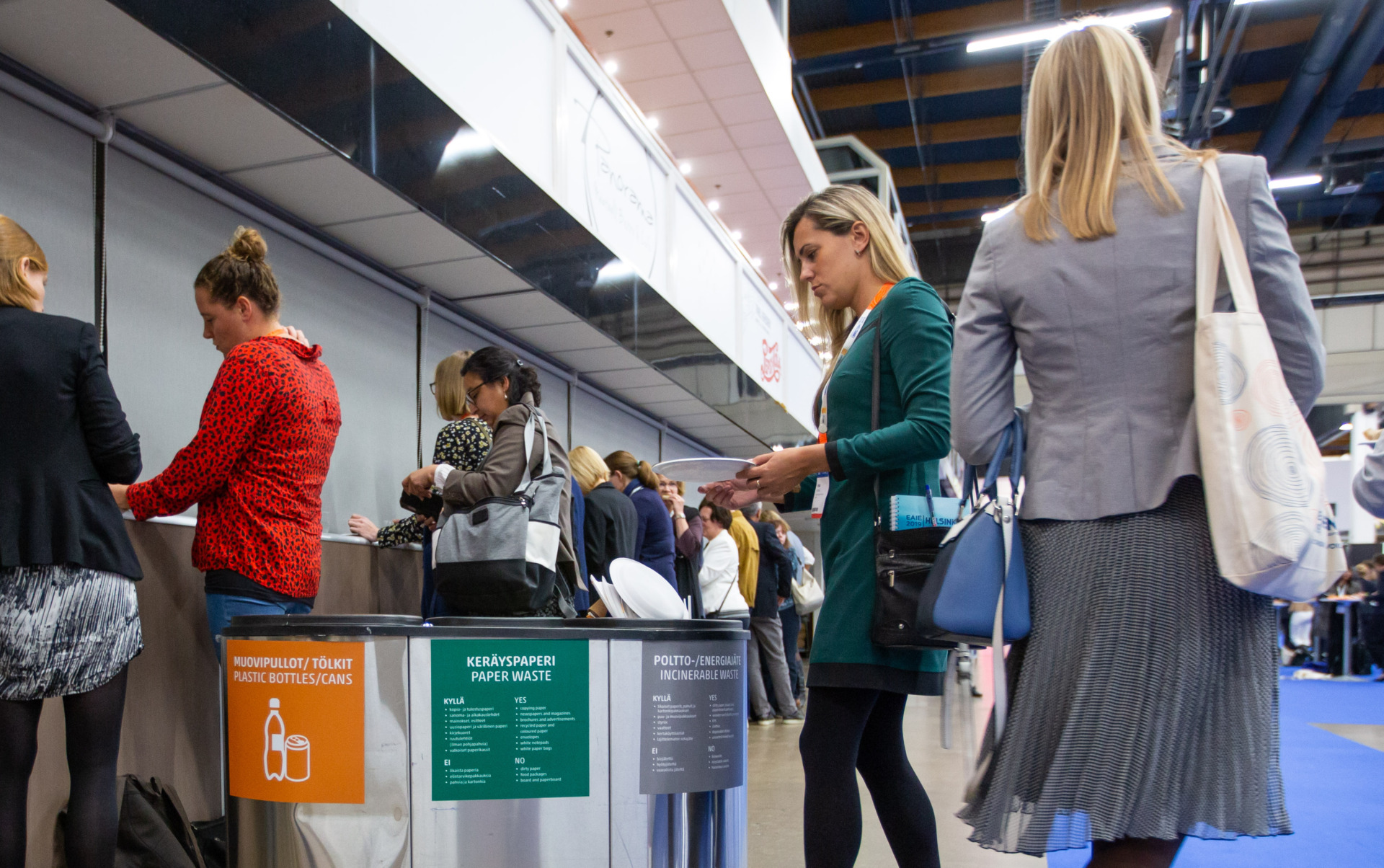
CASE STUDY: EAIE 2019 IN HELSINKI
Striving for a more sustainable event
By Paula Blomster
This is a case study of a large international event organized in Helsinki, Finland. The client and the venue cooperated closely on a wide range of sustainability aspects. The event was planned to meet the requirements of ISO 20121 and progress toward all the United Nations Development Goals was measured and reported. By sharing the experience and the results, these two collaborators wish to be an inspiration for the event industry.
WHO WE ARE
The European Association for International Education (EAIE) organizes the largest international higher education conference in Europe and the second largest in the world. The 31st edition of this conference was held in Helsinki in September 2019.
Messukeskus Helsinki, Expo and Convention Centre is one of the largest venues in the Nordics. It was the first venue in Finland to be granted ISO 90001 and its accomplishments for environmental excellence have been awarded nationally. It has a large solar power plant on its roof, recycles or reuses 99% of its waste and with updated technology tries to minimize the energy and water consumption without compromising the customer experience. In recent years, the work has added more focus on other aspects of sustainability.
Fiona Pelham is a sustainable event industry expert. During this project, she was CEO of Sustainable Events Ltd.
ISO 20121 is a voluntary international standard for sustainable event management, created by the International Organization for Standardization. Fiona Pelham was the chair of this ISO standard. Organizations can demonstrate voluntary conformity with ISO 20121 by either:
First-party self-declaration
Second-party confirmation of conformance by parties having an interest in the organization, such as clients or by certification by an independent third party, e.g. a certification body.
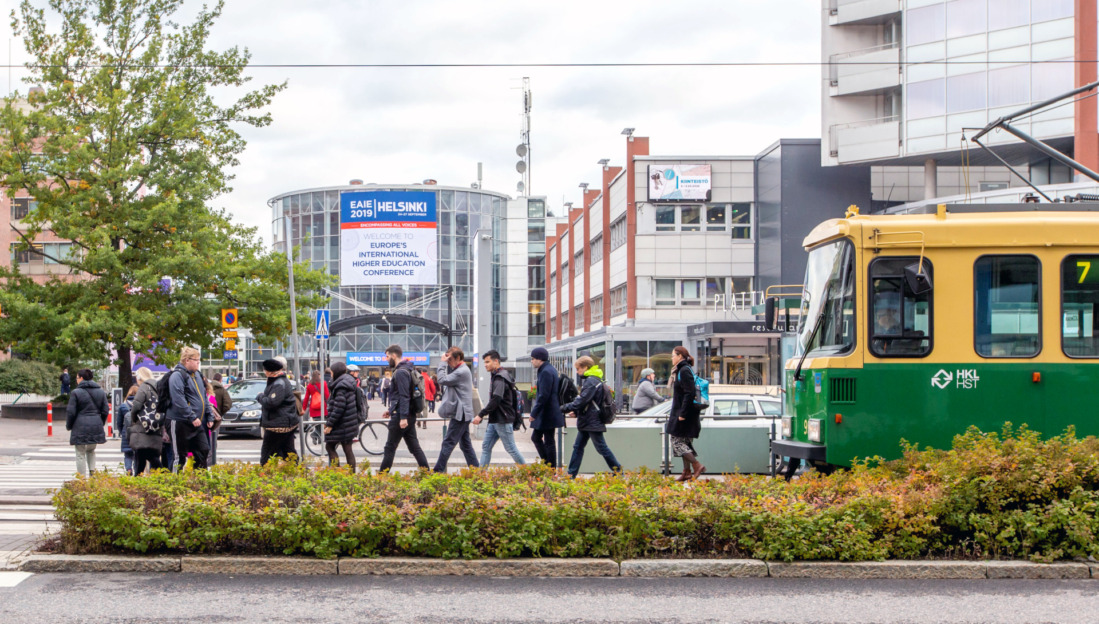
ACTIVITIES AND TIMELINE
May 2018, 15 months to EAIE Conference in Helsinki
As a result of a coincidental meeting between the representatives of EAIE, Messukeskus Helsinki and Fiona Pelham, an idea is born. The EAIE conference held at Messukeskus could become an inspiring case study for our industry in sustainability matters. Running ISO 20121 workshops in cooperation with the client would be a new approach to reach sustainability.
For our project, Messukeskus Helsinki purchased consultant services from Sustainable Events to develop the content and run the workshops.
November 2018, ten months to EAIE Conference in Helsinki
Workshops 1-2
Fiona Pelham herself ran workshops in connection with the EAIE site visit in Helsinki. The event manager of EAIE was in Helsinki to participate in the first two workshops of ISO 20121. From the venue side, the following roles were presented:
- quality manager
- manager of premises
- international sales manager
- the core project team for the EAIE Conference
- project manager
- technical adviser for the exhibition
- service supervisor (for cleaning, security)
- catering (Fazer Foods Ltd.)
- sales manager for AV and WiFi (SVV, subsidiary of the venue)
- head of the marketing and communications came for a briefing
During one day, a lot of material was covered. The scope for the ISO 20121 practice was defined to be international conferences at Messukeskus Helsinki and in this case the 31st edition of EAIE. In a very engaging way, the strategic tools of SWOT and PESTEL were used to define the major issues the participants felt were damaging the environment in the context of conference organization. Legal matters and the interested parties (please note not only “stakeholders”) of Messukeskus Helsinki were listed.
A lot of feelings were put into motion. First, there was excitement as the result of the engaging approach. Second, there was concern among Messukeskus staff over running the SWOT analysis. Could weaknesses be addressed in the presence of our client? However, as we shared everything, the atmosphere became relaxing and extremely inspiring. Roles of the client and supplier were taken away, we were in this together with all our faults and assets.
With the marvelous talent of Fiona Pelham, excitement reached the roof, as all those issues, the negative impacts of the event to be held in Helsinki, were transformed to objectives. We were going to be warriors, fighting against these burdens – the room was full of joy and excitement. It is also important to remember that the participants were not chosen specifically because of their interest in or experience with sustainability; the Messukeskus team was chosen before the ISO 20121 project idea had been born.
Each objective was connected to actions with measurable results. At the same time, each action was linked to one of the company values of Messukeskus Helsinki. I have never seen a strategy taken to an action level in such an efficient and inspiring way.
It was also inspiring to see that objectives which Messukeskus Helsinki found important were also essential for EAIE. It just showed how important it is to keep open communication with your client. This way you will find numerous ways to help each other, which you would not be able to figure out by yourself. The four objectives defined on that day were:
- measure
- waste
- education on sustainability
- clarify an optimal event management approach.
December 2018 – March 2019
As Messukeskus Helsinki was the focus of the consultancy of Sustainable Events Ltd., there were plenty of tasks between the second and the third workshop. Only a fraction of the ideas for actions were drafted during the workshop. In the following months, the quality manager along with the international sales manager had short meetings with the project team and other staff members of the venue.
These discussions were extremely enlightening. New approaches were crafted and old results in matters of sustainability were found. For example, we found out that an event had been organized in three consecutive years, where similar actions had been taken (measuring electricity, water consumption, minimum amount of waste, etc.). Hardly anybody knew about this case within the venue. A short case study was conducted by the communication team. We realized that our sustainability communication was far from perfect. As a result of these workshops, both Messukeskus and EAIE updated their websites to communicate better about their sustainability approach. At the Messukeskus site, there is now also a chance for anybody to comment and contribute ideas on what the venue should be doing. So not only to preach, but to get feedback as well.
Between the second and third workshop, the following actions with measurable results were defined under each objective. You can find our full sustainability plan with more precise information as an attachment (attachment 1)
- Measure
- Construction waste
- Packing waste
- Restaurant waste
- Energy consumption
- Water consumption
- Electricity consumption
- Energy savings by solar panels
- Working hours for volunteers
- Waste
- Reduce amount of construction waste
- Reduce amount of carpet waste
- Reduce amount of organic waste
- Education
- 100% of the staff know about the sustainability matters
- Exhibitors are trained on sustainable matters
- Collect case studies of current sustainable activities
- Update webpage on sustainability
- Engage with interested parties
- Clarity on optimal event management approach
- Use of digital screens
- Decent salaries for all involved
- Benchmarking with other events
March 2019, six months to EAIE Conference in Helsinki
Workshop 3
In March 2019, a representative of Sustainable Events Ltd. ran the third workshop for the same team. Even though this workshop was missing Fiona Pelham’s masterful leadership, it was very useful for two reasons.
First, during the discussions at the venue, the scope “international conferences” had been forgotten. An intimidating monster had surged in these discussions and we had started a process trying to fix all at once. As the team was reminded of the scope, we could breathe again. Fiona Pelham’s approach to put one event in focus is brilliant. Trying to do everything at once you might end up doing nothing. When you concentrate on one event, you will see the full structure and might be able to make changes that will affect all the functions in your event / in our case at our venue.
The second positive aspect for this meeting was that there was a deadline. It is much too easy to leave development work aside, as there are urgent needs from clients and immediate business targets to meet.
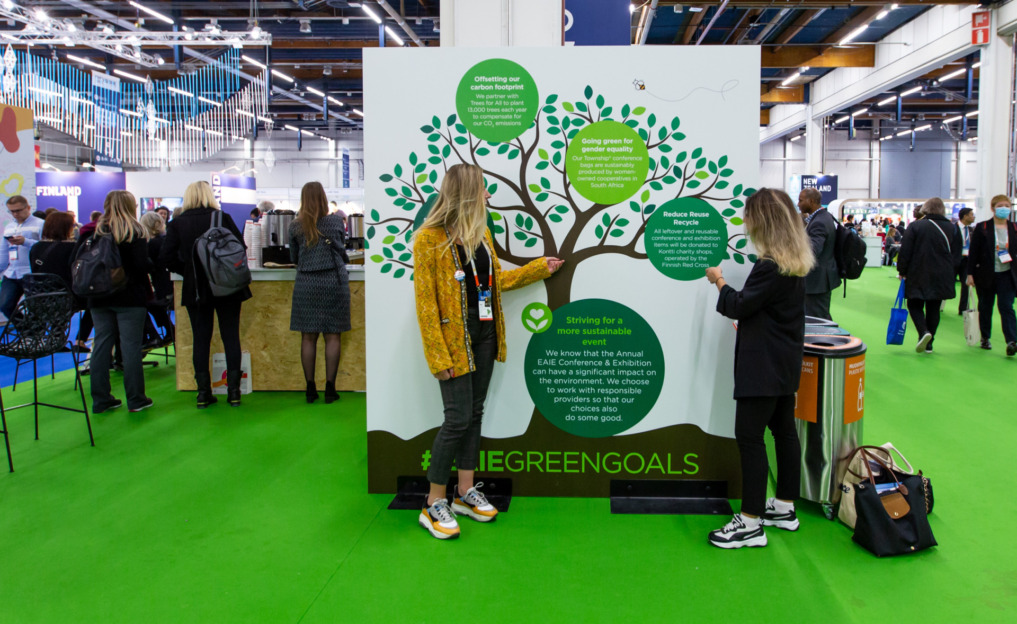
RESULTS
September 24-27, 2019 EAIE Conference in Helsinki
The event had the largest attendance in the history of EAIE – 6,200 participants from 95 countries arrived in Helsinki. In this chapter, some of the results listed in the sustainability plan are investigated.
ENVIRONMENTAL
The CO2 emission savings has been calculated with this tool created by the Finnish event agency Tapaus https://www.tapaus.fi/en/co%e2%82%82-calculator. The tool may not give scientifically proven information, but it certainly gives an idea which areas you need to focus on in order to reduce the environmental impact of your event.
Flight emissions
An international event of thousands of people in Helsinki usually means that most of the participants have to take a plane. The flight-shame should not stop the face2face meetings as we all know that getting together in a conference is not only about receiving information. If that was the case, you would only need to stream the information. But, for example, for EAIE, networking is at least as important. Countries are presented with their educational institutions, services related to higher education in a large exhibition, where exchange programs are created, best practices are shared, and new working groups are developed. The energy, the unplanned encounters and shared information which is hard to define in numbers are hard to reach in the existing on-line formats. Fortunately, EAIE ensures carbon offsetting for all attendee travel to the event. This was done through donating to a tree planting scheme 55,000 EUR, which translated to 13,000 trees planted.
Local travel
Helsinki wants to attract large conferences as any city in the world but wishes to do it without compromising the environment. Participants of large events are granted free transportation tickets costs covered by the City of Helsinki.
The public transportation in the compact metropolis of Helsinki is the quickest way to move around. For example, Messukeskus is the first stop from the central train station. The ride takes four to five minutes, and can be managed by anybody, as every single train stops at that stop. Thanks to this convenience, we estimated that 9,680 CO2 was saved by using public transportation instead of using cabs. Taking a train, a tram or a city bus has additional positive pay offs. It is healthy to walk the short distances from the stops and at the same time a visitor gets more feeling of the host city. During the rides, the informal discussions from the conference can continue.
Catering
Catering is the biggest challenge of all in events, but it also offers an obvious target to reduce carbon footprint in live events. The catering company at the venue, Fazer Foods (today part of Compass Group) has been serious about sustainability matters for some time now.
It uses only locally resourced food; for example, all meat is domestic. Meat, however, is more resource-intensive to produce than plant-based food. The EAIE conference offered a vegetarian lunch on the busiest conference day for 5,360 attendees, reducing CO2 emissions by 15, 264 CO2e kg compared to prior days. No beef was served at the event. The food ingredients presented the fresh harvest of Finnish fall. During the vegetarian day, a Finnish innovation oat-based meat substitute was offered. It has more protein than chicken or beef, showing that vegetarian meal can be filling as well. The food was prepared in the venue and served on biodegradable dishes or on porcelain. No individually packaged food was served.
The coffee served was fair-trade coffee which produced zero waste. Coffee grounds have always been the mission impossible when the catering company tried to reduce its waste. Coffee grounds cannot be deposited in organic waste, and the amount of bio waste produced is unimaginable in the largest venue with over one million visitors annually, in a country that consumes the most coffee in the world. Today, though, the catering company uses “Ice coffee”. The coffee is already pre-processed as it comes to the venue; the coffee grounds have remained as fertilizer in agricultural fields.
The food waste was measured on daily basis. The total of the organic waste, uneaten food during the four-day-conference was 1,215 kilograms, 10% of the food consumed. There is a difficult trade-off for large events such as EAIE. To avoid long queuing times, Fazer Foods and Messukeskus team built a long table with various serving points. This process made feeding thousands of people a quick process. To keep participants happy, the catering company makes sure that each point has enough food, so nobody needs to start queuing again. Once the food has been heated and served, it cannot be offered again, according to Finnish law.
The process to measure all the food waste made clear that certain items such as cookies, fruit and salad was all eaten and did not end up in the organic waste. In order to reduce food waste in future events, the venue should either accept the longer serving time, serve more cold dishes or in the case of EAIE serve more of what their participants seem to enjoy.
Water
Bottled water was not served at the EAIE conference. Plastic bottles are 99% recycled in Finland, so they do not represent such a burden for environment as in some other countries. However, getting them delivered, washed and reused again has an environmental impact and the bottles will also at some point reach the end of their lifecycle.
Instead of bottled water, there were big water tanks around the venue filled with tap water. The Finnish tap water is among the highest quality in the world. It is odourless, flavourless, colourless. Quality of water resources is the secret to this success. There was clear signage to promote this sustainable option even for those participants who might have doubts about drinking tap water. For the ones still in doubt, bottled water could be purchased in cash bars, but thanks to the information campaign and open mind of the participants there were hardly any water bottles consumed during the event. The promotion of tap water saved 9,000 one-litre plastic bottles and became also more economic option for the event organizer.
Construction materials
There was a plan to promote the more sustainable products for the construction builders. However, for this process the project was started too late. The sales of the exhibition were also outsourced to a third company, which could have affected the information flow. Many exhibitors came with their own stands, which are most likely also reusable, but were not included in our reporting. The more sustainable, reusable materials were used in general areas. For example, lecture rooms were carpeted with tile carpets and use of materials from previous events made the plenary hall “best plenary experience ever” according to Holger Omlor, Head of the Events during EAIE 2019. The keys to this success were creativity of the in-house designers and the well-structured communication, thanks to this ISO project.
More importantly, these discussions led to a new “innovation.” The more sustainable construction materials got their own logo in the Messukeskus catalogue for exhibition builders. The impact is strong as Messukeskus Helsinki hosts 1,500 events annually.
Measuring waste and energy consumption
For the EAIE, Messukeskus Helsinki took various additional steps to measure the impact of the event. These are figures which EAIE can follow in their future editions and Messukeskus on its part in the events of a similar size. Unfortunately, the measurement of the solar power production on the roof of the venue, one of the largest plants in Finland, is not managed by Messukeskus Helsinki. Event specific figures are hard to measure at this stage.
It is worth mentioning that Messukeskus Helsinki has an established process of waste sorting. Each hall has its own recycling points, each garbage bin is marked ensuring that only 1% of the waste ends to landfill.
SOCIAL
The theme of the conference was “Encompassing all voices” which had its original idea based on the universal and free educational system in Finland, but it evolved to include the speakers and performers to align that message. Plenary speakers addressed climate change, inequality, inclusion of people of color and the LGBTQ community. “Signmark,” a deaf rap artist, opened the event (if you’ve never heard a deaf artist, please see https://www.youtube.com/watch?v=gfNoMJ1GYzM).
Messukeskus Helsinki is fully accessible to people with a disability, allowing attendance for all. The catering company Fazer Foods Ltd. offered working opportunities for people with partial working capacity during the conference, as the venue itself does in its own events.
Students had a unique volunteering opportunity. Thanks to a co-operation between EAIE and a local school, Haaga-Helia University of Applied Sciences, their event management students worked as conference assistants in the event. The students could experience how a large international conference is run and learn new skills. The initiative had a minimal carbon footprint, as the school is located next to the venue. The experience was valued highly by the school and all students received study points for the experience. The EAIE also has a long-term cooperation with Exeter University, UK, providing Event Management students and International Relations students with valuable intercultural experience.
All left-over materials and re-usable conference materials such as the bags, pens, business gifts were collected and donated to local Red Cross. The collecting points were clearly marked so the participants could leave their unneeded belongings easily in the venue.
EAIE outsourced the production of organic cotton conference bags to a women-owned co-operative in South Africa. An order for over 6,000 participants certainly had a positive impact for the co-operative and helped women in fragile situations.
A CSR activity was organized for conference attendees with the co-operation of the City of Helsinki. Park Pals is a programme organized by the Urban Environment Division in which volunteers help look after Helsinki’s parks and other green areas. The EAIE participants who signed in this activity went to a local park to collect trash. ParkPals gave them gear and assigned the group to the Central Park of Helsinki, short walking distance from the venue, which resembles more of a forest than a park as such. Those attendees who chose to join got exercise, fresh air and created new bonds of community among each other as they were doing good for the hosting destination.
ECONOMIC
Destinations compete intensely to attract international conferences due to their large economic impact. The conference delegates stay longer than an average tourist and have a bigger budget to use on the local services such as accommodation and F&B services. To host a conference of 6,200 delegates is considered a jackpot for local service providers.
The services directly involved with the conference were mainly provided by small and medium-sized companies. The venue for example is a private small-sized, by UK standards, company. However, it is a co-operative dating back to 1919 that has its own foundation which supports many sectors. The catering company is a large company but subcontracts services from local and small companies.
The EAIE works with several companies for their conference materials: conference bags were purchased from an NGO from South Africa, recycled PET lanyards were provided by a Dutch company, cardboard seating was provided by a small Dutch company, as well as certain furniture arrangements (purchasing certain furniture elements which were previously built new every year) and a printing company that uses sustainable processes and materials.
CULTURAL
The cultural pillar of sustainability is many times forgotten in the sustainability approach. The feeling of the local culture was created for the welcome party by the light installations presenting Northern Lights, serving local delicacies and the artistic performance of Ida Elina with the Finnish national instrument “kantele,” a type of dulcimer. Ida Elina deserves special mention as she combines the traditional instrument with international pop music culture reaching a larger audience for the unknown instrument. Local cultural aspects bring unique flavour to events, though they must always be respectful.
TO FINISH
Workshop 4, December 2019
The ingenuity of Fiona Pelham’s approach with the ISO 20121workshops was on show again by holding a wrap-up meeting with all partners. Again, there was a deadline to meet to present the end results of the event. Future activities were addressed, which were the new objectives for the coming year. , Probably most importantly the need to report all the United Nations sustainable goals was addressed. The CEO of Messukeskus attended the workshop and left very inspired “I realized that we can become the best venue globally in sustainability matters.” In two months time, Messukeskus Helsinki was the first venue in Finland to report its actions under each goal. The same was done for the EAIE conference (Attachment 2).
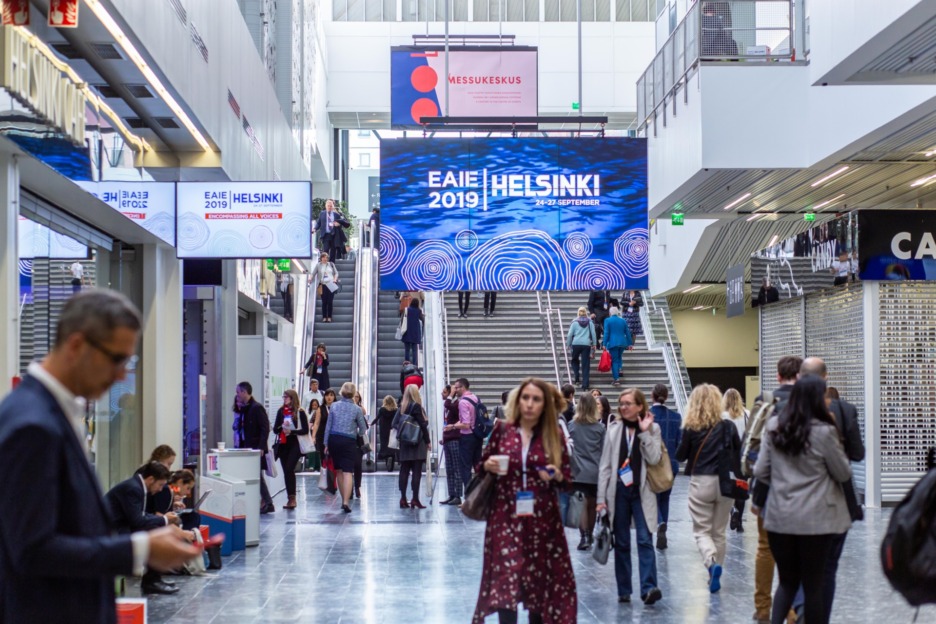
CONCLUSIONS AND RECOMMENDATIONS
The key to the success for this event was the close co-operation between the client and the venue. Speaking openly about the challenges opened the minds of creativity. Equally it is important not to try to solve all the problems at once. This is a process where each new event aims higher. We do not claim that we had the most sustainable event ever, but we did what was possible within this timeline and existing budgets. One of the key learnings could be the communication about the sustainability. This is a way to find solutions. For us, there was low hanging fruit that had not been noticed by the relevant people.
The material for the workshops we went through are now open for anybody at no cost, thanks to the British Embassy of Helsinki. However, it is important to hire an external facilitator to run these workshops and certainly the team of Fiona Pelham is an excellent option. It gives structure, sets up deadlines and ensures that things get done and are not put on the sideline due to the busy business life.
Involve as many people as possible in your institutions on sustainability matters. This is the way to get sustainability embedded in all your actions. We are not there yet but hoping to excel ourselves in each event we organize or is organized in Messukeskus Helsinki.
I also wish to give credit to Fiona Pelham’s approach for not simply giving a check-list of what has to be done, but by taking the longer route starting from the values and needs of each client, and let the client figure out what needs to be done. Some may complain that they do not get ready-made answers and they need to invest time and effort. But this is a sure way to get all your staff involved and to have more lasting and sustainable results.

